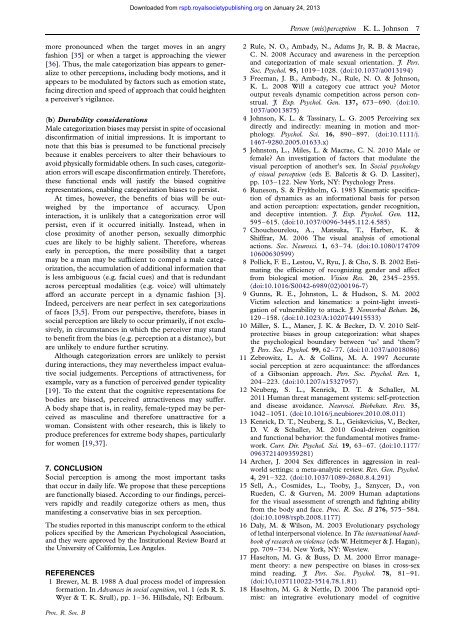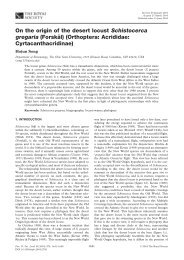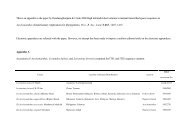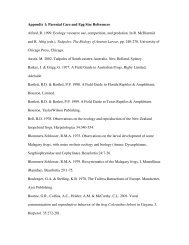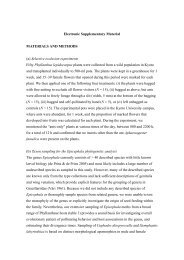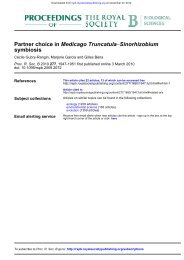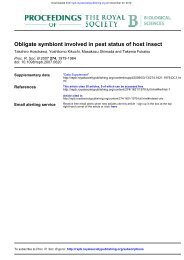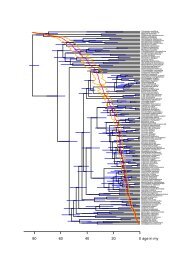Person (mis)perception: functionally biased sex categorization of ...
Person (mis)perception: functionally biased sex categorization of ...
Person (mis)perception: functionally biased sex categorization of ...
You also want an ePaper? Increase the reach of your titles
YUMPU automatically turns print PDFs into web optimized ePapers that Google loves.
more pronounced when the target moves in an angry<br />
fashion [35] or when a target is approaching the viewer<br />
[36]. Thus, the male <strong>categorization</strong> bias appears to generalize<br />
to other <strong>perception</strong>s, including body motions, and it<br />
appears to be modulated by factors such as emotion state,<br />
facing direction and speed <strong>of</strong> approach that could heighten<br />
a perceiver’s vigilance.<br />
(b) Durability considerations<br />
Male <strong>categorization</strong> biases may persist in spite <strong>of</strong> occasional<br />
disconfirmation <strong>of</strong> initial impressions. It is important to<br />
note that this bias is presumed to be functional precisely<br />
because it enables perceivers to alter their behaviours to<br />
avoid physically formidable others. In such cases, <strong>categorization</strong><br />
errors will escape disconfirmation entirely. Therefore,<br />
these functional ends will justify the <strong>biased</strong> cognitive<br />
representations, enabling <strong>categorization</strong> biases to persist.<br />
At times, however, the benefits <strong>of</strong> bias will be outweighed<br />
by the importance <strong>of</strong> accuracy. Upon<br />
interaction, it is unlikely that a <strong>categorization</strong> error will<br />
persist, even if it occurred initially. Instead, when in<br />
close proximity <strong>of</strong> another person, <strong>sex</strong>ually dimorphic<br />
cues are likely to be highly salient. Therefore, whereas<br />
early in <strong>perception</strong>, the mere possibility that a target<br />
may be a man may be sufficient to compel a male <strong>categorization</strong>,<br />
the accumulation <strong>of</strong> additional information that<br />
is less ambiguous (e.g. facial cues) and that is redundant<br />
across perceptual modalities (e.g. voice) will ultimately<br />
afford an accurate percept in a dynamic fashion [3].<br />
Indeed, perceivers are near perfect in <strong>sex</strong> <strong>categorization</strong>s<br />
<strong>of</strong> faces [3,5]. From our perspective, therefore, biases in<br />
social <strong>perception</strong> are likely to occur primarily, if not exclusively,<br />
in circumstances in which the perceiver may stand<br />
to benefit from the bias (e.g. <strong>perception</strong> at a distance), but<br />
are unlikely to endure further scrutiny.<br />
Although <strong>categorization</strong> errors are unlikely to persist<br />
during interactions, they may nevertheless impact evaluative<br />
social judgements. Perceptions <strong>of</strong> attractiveness, for<br />
example, vary as a function <strong>of</strong> perceived gender typicality<br />
[19]. To the extent that the cognitive representations for<br />
bodies are <strong>biased</strong>, perceived attractiveness may suffer.<br />
A body shape that is, in reality, female-typed may be perceived<br />
as masculine and therefore unattractive for a<br />
woman. Consistent with other research, this is likely to<br />
produce preferences for extreme body shapes, particularly<br />
for women [19,37].<br />
7. CONCLUSION<br />
Social <strong>perception</strong> is among the most important tasks<br />
that occur in daily life. We propose that these <strong>perception</strong>s<br />
are <strong>functionally</strong> <strong>biased</strong>. According to our findings, perceivers<br />
rapidly and readily categorize others as men, thus<br />
manifesting a conservative bias in <strong>sex</strong> <strong>perception</strong>.<br />
The studies reported in this manuscript conform to the ethical<br />
polices specified by the American Psychological Association,<br />
and they were approved by the Institutional Review Board at<br />
the University <strong>of</strong> California, Los Angeles.<br />
REFERENCES<br />
1 Brewer, M. B. 1988 A dual process model <strong>of</strong> impression<br />
formation. In Advances in social cognition, vol. 1 (eds R. S.<br />
Wyer & T. K. Srull), pp. 1–36. Hillsdale, NJ: Erlbaum.<br />
Proc. R. Soc. B<br />
Downloaded from<br />
rspb.royalsocietypublishing.org on January 24, 2013<br />
<strong>Person</strong> (<strong>mis</strong>)<strong>perception</strong> K. L. Johnson 7<br />
2 Rule, N. O., Ambady, N., Adams Jr, R. B. & Macrae,<br />
C. N. 2008 Accuracy and awareness in the <strong>perception</strong><br />
and <strong>categorization</strong> <strong>of</strong> male <strong>sex</strong>ual orientation. J. Pers.<br />
Soc. Psychol. 95, 1019–1028. (doi:10.1037/a0013194)<br />
3 Freeman, J. B., Ambady, N., Rule, N. O. & Johnson,<br />
K. L. 2008 Will a category cue attract you? Motor<br />
output reveals dynamic competition across person construal.<br />
J. Exp. Psychol. Gen. 137, 673–690. (doi:10.<br />
1037/a0013875)<br />
4 Johnson, K. L. & Tassinary, L. G. 2005 Perceiving <strong>sex</strong><br />
directly and indirectly: meaning in motion and morphology.<br />
Psychol. Sci. 16, 890–897. (doi:10.1111/j.<br />
1467-9280.2005.01633.x)<br />
5 Johnston, L., Miles, L. & Macrae, C. N. 2010 Male or<br />
female? An investigation <strong>of</strong> factors that modulate the<br />
visual <strong>perception</strong> <strong>of</strong> another’s <strong>sex</strong>. In Social psychology<br />
<strong>of</strong> visual <strong>perception</strong> (eds E. Balcetis & G. D. Lassiter),<br />
pp. 103–122. New York, NY: Psychology Press.<br />
6 Runeson, S. & Frykholm, G. 1983 Kinematic specification<br />
<strong>of</strong> dynamics as an informational basis for person<br />
and action <strong>perception</strong>: expectation, gender recognition,<br />
and deceptive intention. J. Exp. Psychol. Gen. 112,<br />
595–615. (doi:10.1037/0096-3445.112.4.585)<br />
7 Chouchourelou, A., Matsuka, T., Harber, K. &<br />
Shiffrar, M. 2006 The visual analysis <strong>of</strong> emotional<br />
actions. Soc. Neurosci. 1, 63–74. (doi:10.1080/174709<br />
10600630599)<br />
8 Pollick, F. E., Lestou, V., Ryu, J. & Cho, S. B. 2002 Estimating<br />
the efficiency <strong>of</strong> recognizing gender and affect<br />
from biological motion. Vision Res. 20, 2345–2355.<br />
(doi:10.1016/S0042-6989(02)00196-7)<br />
9 Gunns, R. E., Johnston, L. & Hudson, S. M. 2002<br />
Victim selection and kinematics: a point-light investigation<br />
<strong>of</strong> vulnerability to attack. J. Nonverbal Behav. 26,<br />
129–158. (doi:10.1023/A:1020744915533)<br />
10 Miller, S. L., Maner, J. K. & Becker, D. V. 2010 Selfprotective<br />
biases in group <strong>categorization</strong>: what shapes<br />
the psychological boundary between ‘us’ and ‘them’?<br />
J. Pers. Soc. Psychol. 99, 62–77. (doi:10.1037/a0018086)<br />
11 Zebrowitz, L. A. & Collins, M. A. 1997 Accurate<br />
social <strong>perception</strong> at zero acquaintance: the affordances<br />
<strong>of</strong> a Gibsonian approach. Pers. Soc. Psychol. Rev. 1,<br />
204–223. (doi:10.1207/s15327957)<br />
12 Neuberg, S. L., Kenrick, D. T. & Schaller, M.<br />
2011 Human threat management systems: self-protection<br />
and disease avoidance. Neurosci. Biobehav. Rev. 35,<br />
1042–1051. (doi:10.1016/j.neubiorev.2010.08.011)<br />
13 Kenrick, D. T., Neuberg, S. L., Geiskevicius, V., Becker,<br />
D. V. & Schaller, M. 2010 Goal-driven cognition<br />
and functional behavior: the fundamental motives framework.<br />
Curr. Dir. Psychol. Sci. 19, 63–67. (doi:10.1177/<br />
0963721409359281)<br />
14 Archer, J. 2004 Sex differences in aggression in realworld<br />
settings: a meta-analytic review. Rev. Gen. Psychol.<br />
4, 291–322. (doi:10.1037/1089-2680.8.4.291)<br />
15 Sell, A., Cosmides, L., Tooby, J., Sznycer, D., von<br />
Rueden, C. & Gurven, M. 2009 Human adaptations<br />
for the visual assessment <strong>of</strong> strength and fighting ability<br />
from the body and face. Proc. R. Soc. B 276, 575–584.<br />
(doi:10.1098/rspb.2008.1177)<br />
16 Daly, M. & Wilson, M. 2003 Evolutionary psychology<br />
<strong>of</strong> lethal interpersonal violence. In The international handbook<br />
<strong>of</strong> research on violence (eds W. Heitmeyer & J. Hagan),<br />
pp. 709–734. New York, NY: Wesview.<br />
17 Haselton, M. G. & Buss, D. M. 2000 Error management<br />
theory: a new perspective on biases in cross-<strong>sex</strong><br />
mind reading. J. Pers. Soc. Psychol. 78, 81–91.<br />
(doi:10,1037110022-3514.78.1.81)<br />
18 Haselton, M. G. & Nettle, D. 2006 The paranoid opti<strong>mis</strong>t:<br />
an integrative evolutionary model <strong>of</strong> cognitive


